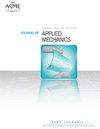Incorporating Geometric Nonlinearity in Theoretical Modeling of Muscle-Powered Soft Robotic Bio-Actuators
IF 2.8
4区 工程技术
Q2 MECHANICS
引用次数: 0
Abstract
Biohybrid actuators aim to leverage the various advantages of biological cells over artificial components to build novel compliant machines with high performance and autonomy. Significant advances have been made in bio-fabrication technologies, enabling the realization of muscle-powered bio-actuators. However, the mechanics of muscle-scaffold coupling has been relatively understudied, limiting the development of bio-actuators to intuitive or biomimetic designs. Here, we consider the case of implementing muscle-based actuation for soft robotic swimmers operating at low Reynolds number. We develop an analytical model to describe the elasto-hydrodynamic problem and identify key design parameters. Muscle contraction dynamics is characterized experimentally and the implications of nonlinear amplitude-frequency relationship of muscle-based actuation are discussed. We show that a novel bio-actuator with high performance can be developed by introducing compliant flexural mechanisms undergoing large deflection. Geometric nonlinearities are accounted for in the analysis of the force-deflection relationship for the flexural mechanism. Our results show that for expected muscle contraction forces, this novel bio-actuator can outperform previous muscle-powered swimmers by up to two orders of magnitude in swimming speed.基于几何非线性的肌肉动力软机器人生物执行器理论建模
生物混合驱动器旨在利用生物细胞相对于人工组件的各种优势,构建具有高性能和自主性的新型顺应机器。生物制造技术取得了重大进展,使肌肉驱动的生物执行器得以实现。然而,肌肉-支架耦合的力学研究相对不足,限制了生物执行器的发展直觉或仿生设计。在这里,我们考虑的情况下,实现基于肌肉驱动的软机器人游泳在低雷诺数操作。我们建立了一个解析模型来描述弹性流体动力学问题,并确定了关键的设计参数。对肌肉收缩动力学进行了实验表征,并讨论了基于肌肉驱动的非线性幅频关系的含义。我们表明,通过引入大挠曲的柔性机构,可以开发出高性能的新型生物致动器。在分析弯曲机构的力-挠度关系时,考虑了几何非线性。我们的研究结果表明,对于预期的肌肉收缩力,这种新型生物驱动器可以比以前的肌肉动力游泳者在游泳速度上高出两个数量级。
本文章由计算机程序翻译,如有差异,请以英文原文为准。
求助全文
约1分钟内获得全文
求助全文
来源期刊
CiteScore
4.80
自引率
3.80%
发文量
95
审稿时长
5.8 months
期刊介绍:
All areas of theoretical and applied mechanics including, but not limited to: Aerodynamics; Aeroelasticity; Biomechanics; Boundary layers; Composite materials; Computational mechanics; Constitutive modeling of materials; Dynamics; Elasticity; Experimental mechanics; Flow and fracture; Heat transport in fluid flows; Hydraulics; Impact; Internal flow; Mechanical properties of materials; Mechanics of shocks; Micromechanics; Nanomechanics; Plasticity; Stress analysis; Structures; Thermodynamics of materials and in flowing fluids; Thermo-mechanics; Turbulence; Vibration; Wave propagation

 求助内容:
求助内容: 应助结果提醒方式:
应助结果提醒方式:


